Izakaya

An izakaya (居酒屋) (Japanese: [izakaja], ee-ZAH-ka-yah)[1] is a type of informal Japanese gastropub. They are casual places for after-work drinking. They have been compared to Irish pubs and early American saloons and taverns.[2]
Etymology
The word "izakaya" entered the English language by 1987.[3] It is a compound word consisting of "i" (to stay) and "sakaya" (sake shop), indicating that izakaya originated from sake shops that allowed customers to sit on the premises to drink.[4] Izakaya are sometimes called akachōchin (red lantern) in daily conversation, because these paper lanterns are traditionally found in front of them.
History
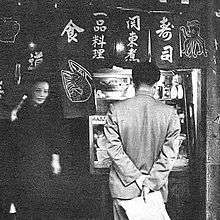
Historian Penelope Francks points to the development of the izakaya in Japan, especially in Edo and along main routes, as one indicator of the growing popularity of sake as a consumer good by the late eighteenth century.[5] Before the Meiji period people drank alcohol in sake shops standing. Some stores started using sake barrels as stools. After that snacks were added.[6]
An izakaya in Tokyo made international news in 1962 when Robert F. Kennedy ate there during a meeting with Japanese labor leaders.[7]
Dining style
.jpg)
Izakayas are often likened to taverns or pubs, though there are a number of differences between these venues.[8][9][10]
Depending on the izakaya, customers sit on tatami mats and dine from low tables in the traditional Japanese style or sit on chairs and drink/dine from tables. Many izakaya offer a choice of both, as well as seating by the bar. Some izakaya restaurants are also tachi-nomi style, literally translated as "drinking while standing".[11]
Usually, the customer is given an oshibori (wet towel) to clean their hands with; the towels are cold in summer and hot in winter. Next a tiny snack/an appetizer called an otōshi in the Tokyo area or tsukidashi in the Osaka-Kobe area will be served.[12] This is local custom and usually charged onto the bill in lieu of an entry fee.
The menu may be on the table, displayed on walls, or both. Picture menus are common in larger izakaya. Food and drink are ordered throughout the course of the session as desired. They are brought to the table, and the bill is added up at the end of the session. Unlike other Japanese styles of eating, food items are usually shared by everyone at the table, similar to Spanish tapas.
Common formats for izakaya (as well as much other) dining in Japan are known as nomi-hōdai ("all you can drink") and tabe-hōdai ("all you can eat"). For a set price per person, customers can continue ordering as much food and/or drink as they wish, with a usual time limit of two or three hours.
Izakaya dining can be intimidating to non-Japanese with the wide variety of menu items and the slow pace. Food is normally ordered slowly over several courses rather than all at once. The kitchen will serve the food when it's ready rather than in formal courses like Western restaurants. Typically a beer is ordered when sitting down before perusing the menu. Quickly prepared dishes such as hiyayakko or edamame are ordered first, followed with progressively more robust flavors such as yakitori or kara-age, finishing the meal with a rice or noodle dish to fill up.[13]
Typical menu items
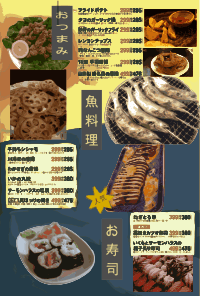
There are a wide variety of izakaya offering all sorts of dishes. Items typically available are:[14][15]
Alcoholic drinks
- Sake (nihonshu)[16] is a Japanese rice wine that is made through the fermentation of rice that has been polished to remove the bran. Unlike wine, the alcohol in sake is produced by the starch being converted into sugars.
- Beer (biiru)[10][16]
- Shōchū
- Cocktails
- Wine
- Whisky
Some establishments offer a bottle keep service, where a patron can purchase an entire bottle of liquor (usually Shōchū or whisky) and store the unfinished portion for a future visit.[17]
Food
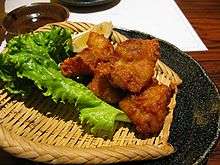
.jpg)
Izakaya food is usually more substantial than tapas or mezze. Many items are designed to be shared.
- Edamame – boiled and salted soybean pods[10]
- Goma-ae – various vegetables served with a sesame dressing[18]
- Karaage – bite-sized fried chicken
- Kushiyaki – grilled meat or vegetable skewers
- Salads[10]
- Sashimi – slices of raw fish[10]
- Tebasaki – chicken wings
- Tofu[10]
- Agedashi dofu – deep fried tofu in broth
- Hiyayakko – chilled silken tofu with toppings
- Tsukemono – pickles
- Yakisoba noodles[10]
- Yakitori – grilled chicken skewers[10]
Rice dishes such as ochazuke and noodle dishes such as yakisoba are sometimes eaten at the end to round off a drinking session. For the most part, the Japanese do not eat rice or noodles (shushoku – "staple food") at the same time as they drink alcohol, since sake, brewed from rice, traditionally takes the place of rice in a meal.
Types
Izakaya were traditionally down-to-earth places where men drank sake and beer after work;[19] this trend is complemented by a growing population of independent women and students. Many izakaya today cater to a more diverse clientele by offering cocktails and wines as well as improving the interior. Chain izakaya are often large and offer an extensive selection of food and drink, allowing it to host big, sometimes rowdy, parties. Watami, Shoya, Shirokiya, Tsubohachi, and Murasaki are some well known chains in Japan.[20]
Akachōchin

Izakayas are often called akachōchin ("red lantern") after the red paper lanterns that are traditionally displayed outside.[21] Today the term usually refers to small, non-chain izakaya. Some unrelated businesses that are not izakaya also sometimes display red lanterns.[22]
Cosplay
Cosplay izakaya became popular in the 2000s. The staff wears the costume and wait on customers. Sometime the cosplay izakaya run shows. Costumes include those for butlers and maids.[23][24]
Oden-ya
Establishments specialising in oden are called oden-ya. They usually take the form of street stalls with seating and are popular in winter.
Robatayaki
Robatayaki are where customers sit around an open hearth on which chefs grill seafood and vegetables. The fresh ingredients are displayed for customers to point at whenever they want to order.
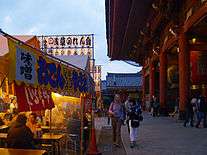 Oden street stall in the property of Sensōji in Asakusa
Oden street stall in the property of Sensōji in Asakusa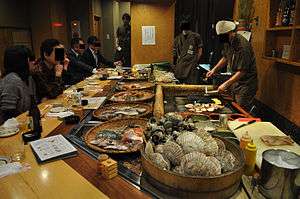 Activity at a robatayaki. Seafood and vegetables to cook displayed
Activity at a robatayaki. Seafood and vegetables to cook displayed
Yakitori-ya
Yakitori-ya specialise in yakitori.[25] The skewers are often grilled in front of customers.
In literature, TV drama and film
Izakaya appear in Japanese novels with adaptations to TV drama and film. They have also inspired manga and gekiga. A modern novel Izakaya Chōji (居酒屋兆治)[26] is an example where the main character manages an izakaya; in the film adaptation, Ken Takakura played the part of Chōji.[27] A TV drama was produced in 1992 on Friday Drama Theater, Fuji Television.[28]
Images of izakaya in jidaigeki novels and films reflect the modern drinking and dining style of today sitting at tables. This was not often seen in countryside – aside from station towns along kaidō highways in the 17th to mid-19th century. Capacities at izakaya were restricted in major cities in the period that jidaigeki TV shows and films/movies set in Edo.
See also
Footnotes
- ↑ "Audio pronunciation". Google Translate. Google.
- ↑ Mente, Boye Lafayette De. AMAZING JAPAN! – Why Japan is Such an Intriguing Country!. Cultural-Insight Books. p. 52. ISBN 978-0-914778-29-5.
- ↑ "Does English still borrow words from other languages?". BBC News. February 3, 2014. Retrieved February 5, 2014.
Some examples that the Oxford English Dictionary suggests entered English during the past 30 years include ... izakaya, a type of Japanese bar serving food (1987)
- ↑
- Hiroshi Kondō (1984). Saké: a drinker's guide. p. 112. ISBN 978-0-87011-653-7.
Literally translated, the word izakaya means a 'sit-down sake shop.'
- Hiroshi Kondō (1984). Saké: a drinker's guide. p. 112. ISBN 978-0-87011-653-7.
- ↑ Francks, Penelope (February 2009). "Inconspicuous Consumption: Sake, Beer, and the Birth of the Consumer in Japan". Journal of Asian Studies. Association for Asian Studies. 68 (1): 156–157. doi:10.1017/S0021911809000035 – via Cambridge University Press. (subscription required (help)).
- ↑ Rowthorn, Chris. Japan. Lonely Planet. p. 88. ISBN 978-1-74220-353-9.
- ↑ "Bobby Regales Japanese with Song Rendition" Monroe Morning World (February 6, 1962): 11. via Newspapers.com

- ↑ Moskin, Julia (April 9, 2013). "Soaking Up the Sake". The New York Times. Retrieved March 19, 2015.
- ↑ Coghlan, Adam. "Introducing izakaya: the new breed of casual Japanese restaurant". London Evening Standard. Retrieved March 19, 2015.
- 1 2 3 4 5 6 7 8 Phelps, Caroline (January 2, 2013). "The Advent of Izakayas". The Huffington Post. Retrieved March 19, 2015.
- ↑ Swinnerton, Robbie (December 9, 2005). "Standing Firm For Tradition". Japan Times. Retrieved October 28, 2016.
- ↑ Mente, Boye De; Ment, Demetra De. The Bizarre and the Wondrous from the Land of the Rising Sun!. Cultural-Insight Books. p. 32. ISBN 978-1-4564-2475-6.
- ↑ How to Izakaya – Kampai! : Kampai!. Kampai.us. Retrieved May 24, 2014.
- ↑ Mente, Boye Lafayette De. Dining Guide to Japan: Find the right restaurant, order the right dish, and pay the right price!. Tuttle Publishing. ISBN 978-1-4629-0317-7. Retrieved January 25, 2016.
- ↑ Alt, Matt; Yoda, Hiroko; Joe, Melinda. Frommer's Japan Day by Day. John Wiley & Sons. p. 263. ISBN 978-0-470-90826-6.
- 1 2 Williams, Wyatt (January 21, 2016). "Long menu, big pleasures at Ginya Izakaya". The Atlanta Journal Constitution.
- ↑ Kamiya, Taeko (1994). Tuttle New Dictionary of Loanwords in Japanese: A User's Guide to Gairaigo. Tuttle Publishing. p. 42. ISBN 0804818886.
botoru kiipu ボトルキープ [Japanese Usage: bottle keep] a system in which one buys a bottle of liquor to be kept at bar
- ↑ Kauffman, Jonathan (February 23, 2011). "What Exactly Is an Izakaya? An Interview with Umamimart's Yoko Kumano". SF Weekly. Retrieved January 28, 2016.
- ↑ Kosukegawa, Yoichi (March 7, 2008). "'Izakaya' are more than just plain pubs". Japan Times. Retrieved January 26, 2016.
- ↑ "Japanese Izakaya". essential-japan-guide.com. Retrieved January 25, 2016.
- ↑ Bunting, Chris. Drinking Japan: A Guide to Japan's Best Drinks and Drinking Establishments. Tuttle Publishing. p. 20. ISBN 978-1-4629-0627-7.
- ↑ Bunting, Chris (2014). Drinking Japan: A Guide to Japan's Best Drinks and Drinking Establishments. Tuttle Publishing. p. 20. ISBN 1-4629-0627-3.
- ↑ "izakaya – a new trend or a lasting option?". Oyster Food and Culture. Retrieved January 25, 2016.
- ↑ "Step Out of the Vegie Patch in a Pair of Onion Tights". RocketNews24. Retrieved January 25, 2016.
- ↑ Bender, Andrew; Yanagihara, Wendy. Tokyo. Lonely Planet. p. 39. ISBN 978-1-74059-876-7.
- ↑ Yamaguchi Hitomi (1982). Izakaya Chōji (in Japanese). Shinchōsha.
- ↑ "Izakaya Chôji (1983)". IMDb. 1983. Retrieved February 6, 2016.
- ↑ Haruhiko Mimura (Director), Hitomi Yamaguchi (writer), Ken Watanabe (Actor), Junko Sakurada (Actor), Tetsurō Abe (Scripter) (2007). Izakaya Chōji (4:3 standard) (DVD) (in Japanese). GAGA, Crime Music Entertainment (Distributer). Retrieved February 6, 2016.
References
- Yamate, Kiichirō (December 20, 1957). 桃太郎侍 (Momotarō-zamurai). Kokumin no Bungaku, color edition (in Japanese). 16. Kawadeshobō.
- Yamaguchi Hitomi (1982). Izakaya Chōji (in Japanese). Shinchōsha.
- Ikenami, Shōtarō (2011). Onihei hankachō II. Kanpon Ikenami Shōtarō Taisei (in Japanese). 5 (reprint ed.). Kōdansha.
- Nihon Eiga Eisei Kabushikigaisha; Shōchiku (2013). "Ikenami Shōtarō and Film Noir" (in Japanese). Fuji Television. Retrieved February 5, 2016.
Further reading
- Izakaya: The Japanese Pub Cookbook (2008) by Mark Robinson, photographs by Masashi Kuma, ISBN 978-4-7700-3065-8, Kodansha International
- Izakaya: Japanese Bar Food (Hardie Grant Publishing 2012), photographs by Chris Chen. ISBN 978-1-74270-042-7.
- Izakaya by Hideo Dekura (New Holland Publishers 2015). ISBN 978-1-74257-525-4.
